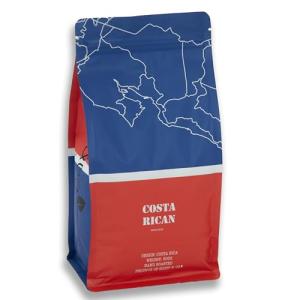Costa Rican coffee beans are a real treat for coffee lovers. They offer a smooth, balanced flavor with a hint of fruity sweetness that makes each sip delightful. Whether you’re waking up in the morning or enjoying an afternoon pick-me-up, these beans promise a tasty experience every time.
Costa Rican Coffee Beans
Experience the rich flavors and vibrant aromas of Costa Rican coffee that will elevate your daily brew
Product List

Costa Rican Medium Decaf Beans
Decadent Decaf
Product Review Score
4.37 out of 5 stars
62 reviews£10.99

Costa Rican Medium Roast Coffee
Scott&Co.
Product Review Score
4.65 out of 5 stars
25 reviews£14.99
Costa Rica has long been recognized for its dynamic landscapes, biodiversity, and thrilling adventure opportunities. However, one of its most notable treasures is often left unmentioned—the rich and flavorful coffee beans. Renowned for their unique flavor profiles and high-quality standards, Costa Rican coffee beans offer a remarkable experience for coffee lovers around the globe. This guide delves into the intricacies of Costa Rican coffee production, the types of beans available, their growing conditions, and why they should be on every coffee enthusiast's radar.
The Costa Rican Coffee Landscape
Coffee production in Costa Rica is not merely an agricultural activity; it is a cultural phenomenon, deeply embedded within the fabric of Costa Rican life. The coffee industry plays a significant role in the economy, employing thousands and contributing immensely to exports.
Key Coffee-Growing Regions in Costa Rica
| Region | Altitude (meters) | Main Varieties | Flavor Profile |
|---|---|---|---|
| Central Valley | 1,200 - 1,800 | Arabica | Bright acidity, fruity notes |
| West Valley | 1,200 - 1,600 | Caturra, Catuai | Balanced sweetness, hints of chocolate |
| Tarrazú | 1,200 - 1,800 | Arabica | Full body, rich aroma, floral notes |
| Turrialba | 1,000 - 1,600 | Arabica | Mild flavor, citrus notes |
| Brunca | 800 - 1,600 | Arabica | Sweet aftertaste, nutty finish |
The Coffee Lifecycle in Costa Rica
The journey of Costa Rican coffee beans from the farm to your cup involves several steps:
- Cultivation: Coffee is typically grown on hillsides at higher elevations, benefiting from cooler temperatures and rich volcanic soil.
- Harvesting: The majority of Costa Rican coffee is harvested by hand, allowing for selective picking—only ripe cherries are collected.
- Processing: Coffee cherry processing can occur in either a wet or dry method, each contributing distinct flavors.
- Drying: After processing, the beans are sun-dried, helping preserve their unique flavor profiles.
- Milling: Once dried, the beans are hulled and graded for quality. Costa Rican beans are often meticulously monitored to ensure they meet high quality standards.
- Roasting: Finally, the beans are roasted, releasing the flavors and aromas that will define the finished coffee.
Understanding Coffee Varieties
Costa Rica primarily grows Arabica beans, which are known for their superior taste and quality compared to Robusta beans. Within the Arabica category, several varieties stand out:
- Caturra: A mutation of Bourbon, Caturra has a bright acidity and complex flavor profile.
- Catuai: A hybrid variety, Catuai is resilient to climate challenges and offers a sweet and fruity taste.
- Geisha: Known for its exceptional quality, Geisha has a floral aroma and delicate flavor, making it a favorite among specialty coffee enthusiasts.
Coffee Health Benefits
Beyond its rich flavor, coffee made from Costa Rican beans provides several health benefits:
| Benefit | Description |
|---|---|
| Antioxidants | Coffee is packed with antioxidants, which can help reduce inflammation. |
| Enhanced Cognitive Function | Caffeine improves alertness, focus, and overall cognitive function. |
| Reduced Risk of Certain Diseases | Regular coffee consumption has been linked to a lower risk of diseases like Parkinson’s and Alzheimer’s. |
| Liver Health | Coffee may protect the liver from conditions such as fatty liver disease. |
Sustainable Practices in Coffee Farming
Costa Rican coffee producers prioritize sustainability and eco-friendly practices. The country passed laws in the 1990s to promote sustainable coffee production, and today, many farms are certified organic or employ sustainable farming methods.
Key Sustainable Practices
- Shade-Grown Coffee: This method maintains biodiversity and provides habitat for wildlife, while also improving coffee quality.
- Water Conservation: Sustainable farms often utilize efficient water management practices to conserve this essential resource.
- Recycling: By-products from coffee production are often recycled or composted, reducing waste and enhancing soil health.
- Fair Trade Certification: Many Costa Rican coffee cooperatives engage in fair trade practices, ensuring fair compensation for farmers and supporting local communities.
Why Choose Costa Rican Coffee?
Choosing Costa Rican coffee comes with several advantages that elevate the overall coffee drinking experience:
- Quality Assurance: Costa Rican coffee farmers have to adhere to strict quality regulations, ensuring consistently high-quality beans.
- Diverse Flavor Profiles: The varied climates of the coffee-growing regions yield beans with distinct flavors, catering to all palates.
- Sustainability: Supporting Costa Rican coffee means contributing to sustainable practices and community welfare.
FAQ: Your Costa Rican Coffee Questions Answered
What is the best way to brew Costa Rican coffee?
When brewing Costa Rican coffee, methods such as pour-over, French press, or a coffee maker can bring out the best flavors. The brew method often depends on personal preference, but a medium grind and a water temperature of around 90-94°C (195-201°F) is commonly recommended for optimal taste.
How do I know if my Costa Rican coffee is ethically sourced?
Look for certifications like Fair Trade, Rainforest Alliance, or organic labels on the packaging. These indicators guarantee that the beans have been sourced with regard for sustainable practices and fair compensation for farmers.
Where can I purchase Costa Rican coffee?
Costa Rican coffee is available in specialty coffee shops, online retailers, and some grocery stores. Many farms also offer direct-to-consumer sales through their websites.
Are there different roast levels for Costa Rican coffee?
Yes! Costa Rican coffee can be found in various roast levels ranging from light to dark. Lighter roasts tend to highlight floral and fruity notes, whereas darker roasts reveal richer, more robust flavors.
Costa Rican coffee beans represent not just an agricultural product, but a labor of love that embodies the country's dedication to quality, sustainability, and unique flavors. By appreciating each cup of Costa Rican coffee, consumers support an industry that is committed to excellence and responsible practices. The next time you sip on a cup, take a moment to relish the complexity and richness that each bean brings to your coffee experience. It's an adventure worth savoring.